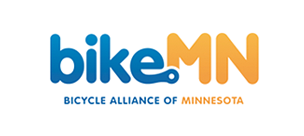All About the Stop as Yield (Safety Stop)
By angela olson, Deputy Executive Director and Director of Education
I ride my bike nearly every day as a form of commuting, and have done so since I was 16 when I would ride to my first job at the local coffee shop. In those twenty years of ridership, I have learned a lot about driving behavior (both of motor vehicles and bikes), best practices, and safety. One of the most important lessons I’ve learned, and is critical to our education work here at BikeMN, is that bicyclists fare better when they generally act as traffic.
When I bike to our central office in South Minneapolis, I know that I’m responsible for my own safety, and that I have to make the choices that are safest for me. I try to be visible and predictable. Sometimes being safest for me might mean making a choice that motor vehicle drivers might not know is actually safer – for example, utilizing the travel lane, even if a bike lane is present. I might do this because of snow in the bike lane, someone opening a car door, I may be turning left, or because I want to be the most visible.
Intersections are areas where I know I need to be particularly aware of my safety (just like when I drive my car). Now, when navigating intersections with stop signs, I have an additional, legal, choice to make when it’s safest for me – the Safety Stop.
This past legislative season, BikeMN helped write and pass HF 2887. An important law change written into this bill is the Stop as Yield maneuver, also known as the Idaho Safety Stop.
What is the Safety Stop?
Under Minnesota law, bicyclists may now treat stop signs as yield signs at intersections when it is safe for the rider to do so. This law change (unlike the law in Idaho) does not apply to traffic lights. Bicyclists must still stop and wait at all traffic control lights until the light changes to green (just like all other traffic).
Why is it safer for bike riders?
The National Highway Traffic Safety Administration published a great fact sheet all about the benefits and studies surrounding Stop as Yield in March 2023. In general, someone riding a bike is safest when they have control over their own safety, and being able to “roll through” a stop sign is a way to keep momentum (keep traffic flowing! Reduce the risk of skids!) and stay visible. Making it legal to treat a stop sign as a yield sign also decriminalizes a riding behavior, minimizes conflict with law enforcement, and encourages even more people to ride.
Does this mean that bicyclists can just ride through any stop sign they want?
No! The law specifically states that bike riders may “roll through” a stop sign when safe to do so. The bicyclist must judge the safety of the situation and act accordingly at the intersection. If cross traffic is not required to stop, for example, someone riding a bike can’t simply zoom through and expect cars to stop for them. It would not be safe or legal.
As laws change to adapt to transportation behavior and safety, we all have things to learn and grow from. As we teach at BikeMN, we all deserve to get to where we are going safely, regardless of how we travel.
Can bicyclists utilize the Safety Stop at a Stop Light?
No, while data suggests this too is a best practice, the Minnesota statute does not allow for this. Many states do allow for this same provision to be allowed at signalized intersections, this is not the case in Minnesota. As an organization that promotes the best practices for safe biking, walking, and rolling; we hope to see this provision added to the law in a future session. We believe the Safety Stop at stop signs is a good starting point to show that this measure is both safe and prudent.
To learn more about the Safety Stop or about BikeMN’s programs, contact angela@bikemn.org
Support safe biking, walking, and rolling in Minnesota
